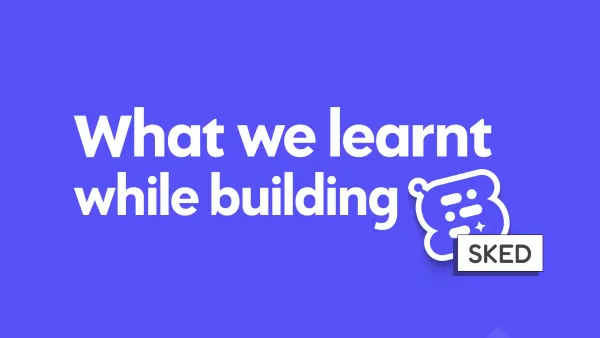We just launched Sked — an AI-powered scheduling assistant for Slack. Building it, our very first piece of software, shattered more myths than we can count and taught us lessons we wouldn’t have learned in a hundred years. Here’s everything we picked up along the way.
It felt simple… until it wasn’t
When we started building Sked – the idea felt clear and focused. Find slots, book meetings, reschedule or cancel, all using natural language, powered by GPT APIs – all within Slack. We had a strong team and a crisp scope. It looked like something we could ship in a month.
It took six.
Not because we weren’t executing – we were – but because the deeper we went, the more we saw how hard “simple” actually is.
There’s a whole world under one click
Take “find slots,” for example. Scheduling even one meeting is more painful than it should be – open five tabs, check calendars, add attendees, scan for overlaps, choose Zoom or GMeet, set a title, send the invite, and then someone replies, “Can we move this?” It’s slow, fragile, and constantly breaks your focus.
We assumed it was a calendar problem: pull events via API, find overlaps, show the top options. Done.
Except it wasn’t. You have to consider time zones, public holidays, out-of-office blocks, working hours preferences, last-minute edits, half-day overlaps. And when there’s no match, do you extend the date range? Suggest shorter meetings? Prioritise someone’s calendar? The logic tree kept branching.
Then there’s language. People say the same thing in different ways – “next Friday,” “Friday next,” “sometime after lunch,” “free before 2pm” – and they expect the tool to just get it. We had to build not just logic, but understanding. Without slowing things down.
Every design choice became a tradeoff between speed, accuracy, and empathy.
The product loop was real – because the pain was real
We were building Sked while using it ourselves. Every friction point we hit went straight to the backlog. Every little delight we wanted became a spec. That feedback loop – between being the maker and being the user – made everything sharper.
It removed guesswork. It gave urgency to tiny things. And it reminded us who we were really building for – not an imaginary persona, but people just like us trying to do less clicking and more thinking.
We launched slow – on purpose
We had a working version at the end of Month 1. But we spent the next five months rewriting flows, catching edge cases, caching repeated requests, handling Slack weirdness, rewriting prompts that didn’t feel human, tuning latency, and tightening the interface until it felt usable.
Not perfect – just usable in a way that felt calm, intentional, and complete.
We didn’t want to ship something noisy or half-baked. We weren’t chasing hype. We just wanted to build something we’d be proud to use ourselves. Something that could earn trust – not demand it.
There’s a line from Basecamp we kept coming back to: Build software like it’s your life’s work. That anchored us.
Simple tools are the hardest to build
Sked gave us a whole new respect for the tools we already loved – Notion, Figma, Superhuman. The ones that feel like air. You forget how much is going on under the hood because someone else has already done the thinking.
Good software disappears into your day. That became our benchmark. We weren’t trying to be the smartest tool in the room – just the quietest, most helpful one.
It reminded us of watching Federer play tennis. Everything looks smooth, almost lazy, until you realise what it takes to make it look that easy – years of invisible work. Great tools are like that. They hide the grind.
Because in the end, great software isn’t about clever features. It’s about empathy. It sees where you’re tired and takes one thing off your plate. That’s what we wanted Sked to do.
Still early, but heading somewhere
Sked is still young. Still imperfect. But it works. And more than that, it feels right.
It lives where work already happens – in Slack. It doesn’t ask for your attention. It doesn’t pull you out of flow. It just helps you get the meeting scheduled and move on.
We built it to reduce chaos, not add to it.
To the team – thank you. You stayed through the late nights, the debug loops, the Slack edge cases, the “this worked yesterday” mysteries. You cared about the tiny things. You made something thoughtful, and it shows.
Where we’re headed
Slack is where work happens – but it wasn’t designed to help your mind rest. And the more work moves into chat, the more tools need to feel calm, clear, and helpful.
We want to build tools that simplify cognition. That carry the mental load. That give people space to think – not just react.
They say a CEO should have a clean desk. But aren’t we all CEOs of our own lives? Shouldn’t our minds be a little clearer too?
AI gives us the scaffolding. It can sort, remember, plan, and adapt – so we can use our brains for something better than chasing reschedule requests.
We don’t know exactly how we’ll get there. But we’ve found something that keeps us going – the self-propelling joy of building. The quiet thrill of shaping something useful and sending it out into the world.
That’s enough to keep going. This is just the beginning.
